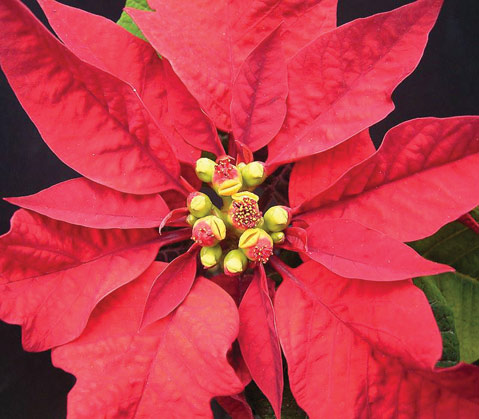Gardening: The Fiery Poinsettia
The Holiday Icon with the Bright Red Flowers

Poinsettias are one of the standard floral decorations this time of year. Euphorbia pulcherrima, now known to all by its common name poinsettia, was originally called the Mexican fire plant for its flaming red flowers. In its native habitat in the vicinity of Taxco, Guerrero, it can grow to a large shrub of 10 feet or more. It forms stiff canes that are juicy but not really succulent. The showy flower parts are actually bright red modified leaves surrounding tiny greenish-yellow flowers. This denizen of the Mexican flora makes its lovely display of cheery red blossoms at about the right time of the year for Christmas, so it has become one of the icons of North American holiday celebrations. That is not the entire story, however.
Because poinsettias grow pretty readily from cuttings and exhibit a nice range of natural variation in flower shape and coloration, aspiring growers have found something new to offer with some regularity. There are poinsettias with twice, or even three times, as many showy bracts. The bracts can range from nearly white (a lovely ivory) to strawberry-ice-cream pink to the standard scarlet. And there are some with variegations, too. Couple that with a predisposition to thrive in adverse conditions, and you’ve got the makings of a marketing winner.
One of the largest growers is located in San Diego County. Paul Ecke and his family (three generations of them now) started growing poinsettias on their ranch in the early 1900s, and by 1920 they were seriously engaged in promoting them as the official holiday flower. They now market more than 60 different selections in colors ranging from white through cream, salmon, pink, red, and even purple.
The old standby single-bracted red is still a favorite with most people. What many may not know is that poinsettias can be established outdoors in our mild climate, just as they grow in Mexico. It will require a sheltered spot — against a warm wall or in a south-facing aspect — to ensure maximum success. There are some poinsettia bushes in old neighborhoods that reach to the roofline and provide a brilliant winter display. The trick to keeping them going and increasing is to faithfully cut last year’s canes down to the ever-more-gnarled stump every July. The new canes will nearly reach the eave by December and be brilliantly aglow in time for Christmas. Bouquets of the flowers can also be harvested (without harming the mother plant) with care. The trick is to quickly sear the cut end of the stems with a flame, solidifying the milky latex that oozes out before plunging them into a bucket of water. This sap, if not dealt with, can clog the water-conducting tubes within the stem allowing the plant to wilt even though its stem is standing in water.
This is the time also to dispel that myth that poinsettias are extremely dangerous and poisonous. The milky sap in the stems and leaves is mildly irritating, but it would require massive amounts to be debilitating or deadly to pets or humans. Wash off any residue with soap and all will be well.
The days are nippy, and the nights are still getting longer. Time to spend happy hours indoors. Set the holiday mood with the cheer of bright poinsettias.



